
 Marine Nationale, 1899-1954:
Marine Nationale, 1899-1954:Gloire, Marseillaise, Sully, Amiral Aube, Condé
WW1 French Cruisers
Sfax | Tage | Amiral Cecille | D'Iberville class | Dunois class | Foudre | Davout | Suchet | Forbin class | Troude class | Alger class | Friant class | Linois class | Descartes class | D'Assas class | D’Entrecasteaux | Protet class | Guichen | Chateaurenault | Chateaurenault | D'Estrées class | Jurien de la Graviere | Lamotte-Picquet classDupuy de Lome | Amiral Charner class | Pothuau | Jeanne d'Arc | Gueydon class | Dupleix class | Gloire class | Gambetta class | Jules Michelet | Ernest Renan | Edgar Quinet class
The Gloire class consisted of five armored cruisers built for the French Marine Nationale in 1901-1904, designed after a long internal debate in the Navy staff between three factions to determine the best type of cruiser in the next decade. A compromise was found and the Gloire class was approved in 1897 With a mixed armament of 7.6 in/6.5 in guns, and fleet-capable operations. Completed in 1903–1904, they served with the Northern Squadron, some operating in the far east, Mediterranean Squadron, where all met in 1910 in the 2nd Light Squadron, quite active in WWI. They served in the Far East, North sea, and Mediterranean and all fronts in WWI, including the black sea in 1919. Two survived in the 1920s, and on was still a training ship in 1944. #ww1 #marinenationale #frenchnavy.
Design Development of the Gloire class (1896-1899)

A nice view of Gloire’s forward section during an hommage to Vendemiaire (agence Rol). It shows in order, the capstan, main battery forward turret, conning tower, bridge and concidene rangefinders above, and fighting top with the four 37 mm Hotchkiss. Above was a spotting top and a platform for a projector.
By mid-1897 the three factions inside the navy staff, the Jeune École, traditionalists and modernists fiercely debated since 1896 over a newly authorized class of five cruisers:
-The Jeune Ecole (Young School) wanted fast, lightly armed ships for commerce raiding, faithful to their asymetric naval warfare credo.
-The traditionalists wanted cruisers to defend colonies, a quite extensive network between Africa, the Indian Ocean, Pacific and far East.
-The modernists desired both armored cruisers and small scout cruisers to operate with the fleet. Only their first would be accepted. They had to wait for 1912 for the second.
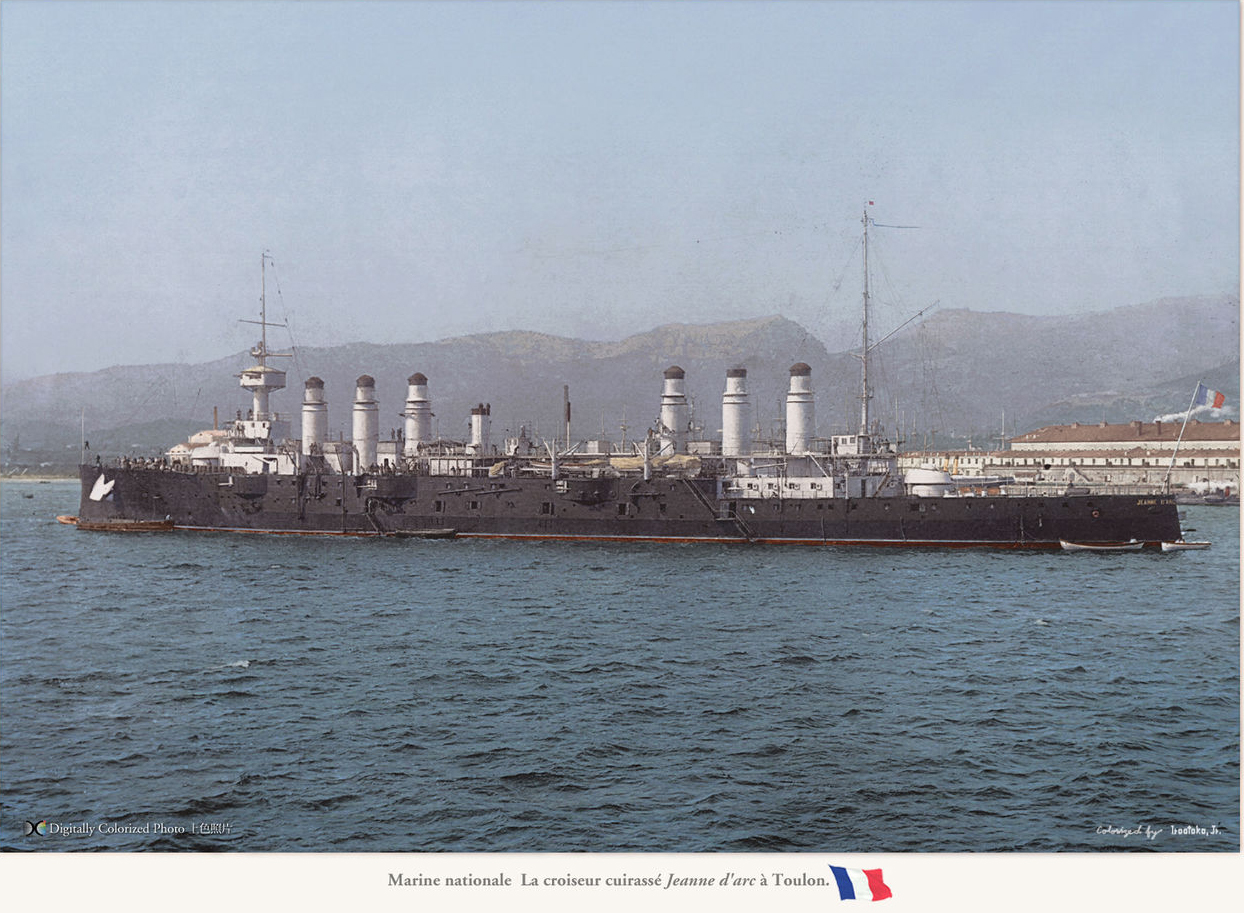
The previous Jeanne D’Arc, that quickstarted this new serie.
They came to a consensus that balanced armored cruisers could fulfill all these roles. The five cruisers intended to work with the fleet had been authorized already as part of the 1896 construction program but only three, the Gueydon class, would be ordered in 1897. Later Navy Minister and Vice Admiral Armand Besnard ordered Louis-Émile Bertin, Director of Naval Construction (“Directeur central des constructions navales”) started design work on an enlarged successor to the Gueydons with 500 metric tons (490 long tons) of extra displacement as room for improvements.

Artist depiction of the class in Brassey’s naval annual 1904
The 1896 construction program was amended in 1898. It was now to include six more armored cruisers, three of which were intended to be laid down under FY 1898. Édouard Lockroy (new Naval Minister), a politician, approved the new design based on the DNC previous work, and on 17 September ordered the first two in naval dockyards, while the remaining three would have their orders confirmed in 1899.
Detailed Design
Hull and general design

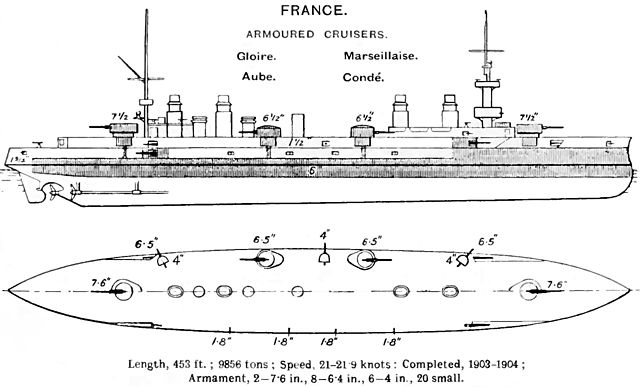
Comparison between the Gueydon and Gloire (Brasseys naval annual 1906 and 1912).
The additional weight decided by Besnard, on advices from Bertin, enabled the new Gloire-class to have an increasing height above the waterline and higher armored belt, with the extra benefit of adding more torpedo tubes. The final hull was established at 139.78 meters (458 ft 7 in) in overall lenght, 20.2 meters (66 ft 3 in) in beam, and 7.55 meters (24 ft 9 in) draft, more comfortable dimensions indeed compared to the Gueydons. This went for a displacement of 9,996 metric tons (9,838 long tons) compared to the Gueydon’s 9,516 tonnes for 139.90 m (459 ft) in lenght but 19.38 meters (63 ft 7 in) in beam.

Conway’s profile of the class.
The crew amounted to 25 officers and 590 enlisted men, more than the 566 officers and ratings of the Gueydon’s. Now, on the general design itself, they still resembled their forebears, with a long forecastle, limited tumblehome and modest ram bow, almost straight, a bridge with a thick military mast forward (with fighting and spotting top, going up), tall mainmast aft, two pairs of heavenly spaced funnels, and service boats on davits either side. For more, plans kept at Chatelleraut seems to not have been digitzed for this class yet.
Armour protection layout
The Gloire class had a main armored belt made with Harvey face-hardened armor plates.
-The main waterline belt was 150 mm (5.9 in) amidships and tapered down to 90 mm (3.5 in) forward past the barbette and 80 mm (3.1 in) aft.
-The upper belt strake was 130 mm (5 in) amidships tapered down 80 mm fwd and 70 mmm (2.8 in) aft. These outer strakes however were in less resistant nickel steel.
-ASW compartimentation extensive: (Bertin-style ship) Watertight internal cofferdam, backed by a longitudinal watertight bulkhead.
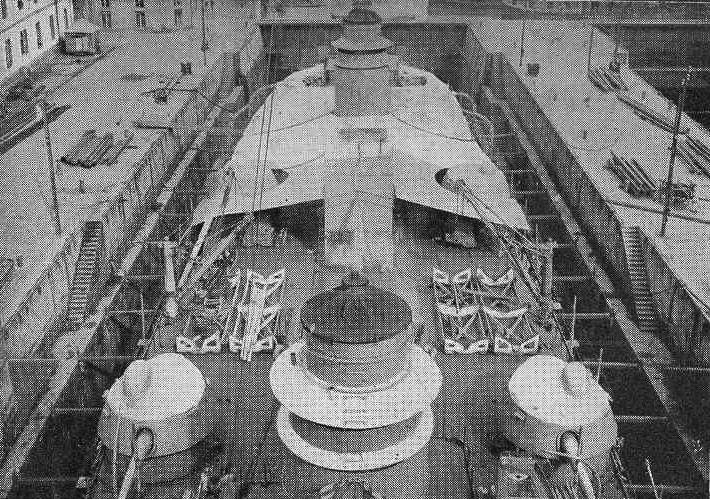
-Main-gun turrets 161 mm (6.3 in), Harvey armor all around.
-Main barbettes 174 mm (6.9 in) in ordinary steel.
-Secondary turrets faces/sides 92 millimeters (3.6 in)
-Secondary turrets barbettes 102 millimeters (4 in).
-164.7 mm casemates 102 millimeters.
-Conning tower 174 mm thick walls.
-Forward transverse bulkhead 100 mm (3.9 in) thick
-Aft transverse bulkhead 40-84 mm (1.6 and 3.3 in).
-Lower armored deck (made in mild steel plates) 25 mm (0.98 in), flat and sloped sections.
-Upper armored deck 24 mm (0.94 in) hardened steel.
Powerplant

These cruisers innovated little in this field and retook the Gueydon’s machinery essentially: They had three vertical triple-expansion steam engines each on a single propeller shaft. The idea of three shaft was that the axial one would be reserve fo cruising and the outer ones for speed and manoeuver, with different pressures.
In total this machinery was rated for 20,500 metric horsepower (15,100 kW) – To compare with Gueydon’s 21,500 shp), with the steam coming from 28 Belleville water-tube boilers.
Condé and Gloire had Niclausse boilers instead, a choice of their Yard.
This enabled a speed of 21 knots (39 km/h; 24 mph), but 21.27–21.88 knots (39.39–40.52 km/h; 24.48–25.18 mph) on trials based on 20,110–22,331 PS (14,791–16,424 kW). To compare with the Gueydon’s 21,4 nœuds. For range, they carried 1,660 long tons (1,690 t) of coal, enough for 6,500 nautical miles (12,000 km; 7,500 mi) at 10 knots. To compare, the Gueydons carried 1,575 tons of coal, for a 5,000 nm raduis at 18 knots according to some sources.
Armament

The main difference betwen the Gloires and Gueydons were in the armament’s repartition. They carried the same battery, but the Gloires had four of the previously casemated secondary guns relocated in deck turrets. It was homogeneous, with three calibers, main, secondary and light QF (2 calibers) anti-torpedo boat armament. But the torpedo armament was also superior to the Gueydon’s.
Main
The main battery of the Gloire class rested on two quick-firing (QF) 194 mm (7.6 in) Mod. 1893–1896 guns. Same as the Gueydons. They were mounted in single-gun turrets fore and aft.
These fired a 75–90.3-kilogram (165–199 lb) shells (depending of its AP or HE nature) at a muzzle velocity of around 770-800 meters per second (2,500 to 2,600 ft/s).
Range was about 11,500 meters (12,600 yd) at +15° elevation. Each had a reserve of 100 shells. ROF (Rate of Fire) was two rounds a minute.
Secondary

The secondary armament was split in two caliber, consisting of eight QF 164.7 mm (6.5 in) Mod. 1893–1896 guns plus six QF Canon de 100 mm (3.9 in) Mod. 1893 (two more compared to the Gueydons).
Four 164.7 mm were in two single-gun wing turrets on the broadside, forming a triangle pattern with the axial main turrets fore and aft.
The remaining ones were in single hull casemates.
They fired 45–54.9-kgs (99–121 lb) shells, HE or AP, fired at 900 meters per second (3,000 ft/s) and with a ROF of 3 rounds per minute. At +15° elevation they reached 10,800 meters (11,800 yd), which was almost the same as the main guns. Thus they completed well the slower-firing main guns.
200 rounds were in store for each of these gun.
The six 100 mm guns were located in casemates, two in the froward section of the hull, close to the bow, two in upper superstructure forward, and two in recesses aft, also above the main secondary casemates.
They fired a 14–16-kilogram (31–35 lb) shell (AP/HE) with a muzzle velocity of 710-740 meters per second (2,300 to 2,400 ft/s). Each had a storage of 250 rounds, all stowed in the casemates, and ROF was six rounds per minute.
Anti Torpedo-Boat armament
Their anti-torpedo boat defence rested on eighteen Hotchkiss M1886 47mm/40 -instead of 10 on the Gueydons- (1.9 in) and four Hotchkiss 37mm/40 (1.5 in) guns, the latter usable as saluting guns but not usable for a landing party as they were located in the fighting top. They were all in single mounts. Oddly enough, according to the photos above, these guns were presented as “AA guns”. They indeed had quite an important elevation that could enable this possibility. But being shoulder-moved and slow-firing contact-exploding shells, they would have been inefficient for this role.
These 47 mm guns were located in various positions: Four on the superstructure’s roof, on the corners, four in hull’s casemated position in recesses, one in stern chase, three either broadside also in casemates, just above the main belt. Their usefulness in heavy weather was dubious.
Torpedo Tubes
The Gloire class received a better torpedo armament, with five 450 mm (17.7 in) torpedo tubes: A submerged pair and another above water (4), broadside, and the last in the stern and also above water, on pivot mount like the ones of the broadside. Underwater tubes were fixed. In between they shared a stock of sixteen torpedoes. The ships could also be equipped to carry between 10 and 14 naval mines. This capability was never exploited.
Modifications
During WWI, it’s likely that many of these Hotchkiss guns were landed at some point during a refit and replaced by at least two high-angle 75 mm AA guns. Only Marseillaise was thoroughly modified to be used as training ship.
Condé was largely disarmed as demoted as a barrack ships and later depot ship for submarines in the interwar. She was used as a tender for German U-Boats while in Lorient in WW2 and thus, perhaps rearmed with some modern AA by the Germans, but this information is researched right now for the WW2 section. As for Marseilaise again, she had her main fore and aft guns replaced by 164 mm guns instead, also in turrets in 1925. That’s about all which is known. She was retired in 1929.

Author’s profile.
⚙ Gloire class specifications as built |
|
| Displacement | 9,996 t (9,838 lt) standard |
| Dimensions | 139.78 x 20.2 x 7.55m (458 ft 7 in x 66 ft 3 in x 24.8 ft) |
| Propulsion | 3 shafts VTE, 28 wt boilers 20,500 PS (15,100 kW) |
| Speed | 21 knots (39 km/h; 24 mph) |
| Range | 6,500 nautical miles (12,000 km; 7,500 mi) at 10 knots |
| Armament | 2× 194, 8× 164, 6× 100, 18× 47, 4× 37, 5x 450 mm TTS |
| Protection | Main belt 5.9-2.8 in, turrets 6.3-in, bkhds 3.9-in, CT 6.9-in |
| Crew | 615 |
General Assessment of the Gloire class

Victor Hugo of the next Gambetta class. They were much larger, reaching 13,000 tonnes FL, and carried almost double the armament.
Design-wise, the Gloire class were surely an improvement on their commerce-raiding capabilities, with a slightly better range (but not better speed), larger armament and more flexible secondary turrets for better arc of fire, more guns of intermedediate and light armament plus more torpedo tubes for closer quarters. Armour was generally better, and their main armament was still ranged enough for a battlefleet use at the time. But in general they were too weak to engage anything else but their own kind.
Note that in this post, no word as been said about the Dupleix class, which will be seen next. They were started in the same 1896 programme, but the three cruisers were only 7000 tonnes, seen as weaker versions for the Gueydon/Gloire and one-off pure commerce raider experiment (not fleet capable) armed only with lighter caliber, 6.4-in and 4-in guns. But still armoured cruisers capable of combating other escorting cruisers.
 It should be also said at this point that the “Jeune Ecole” wanted and had it’s serie of “pure” commerce raider, largely unarmoured or lightly protected from 1894, D’Entrecasteaux, Guichen, Chateaurenault (which even faked a liner’s silhouette !) and Jurien de la Gravière. Better jugdment prevented more to be built and greater efforts put into more versatile and capable armoured cruisers instead. As for “scouts” asked for the modernists, the last closest to home was “Milan” in… 1884. The French scout program was planned by Admiral and Navy minister Boué de Lapeyrière in 1912 but never realized. It was eventually the basis for the 1920s Duguay-Trouin class.
It should be also said at this point that the “Jeune Ecole” wanted and had it’s serie of “pure” commerce raider, largely unarmoured or lightly protected from 1894, D’Entrecasteaux, Guichen, Chateaurenault (which even faked a liner’s silhouette !) and Jurien de la Gravière. Better jugdment prevented more to be built and greater efforts put into more versatile and capable armoured cruisers instead. As for “scouts” asked for the modernists, the last closest to home was “Milan” in… 1884. The French scout program was planned by Admiral and Navy minister Boué de Lapeyrière in 1912 but never realized. It was eventually the basis for the 1920s Duguay-Trouin class.
The armoured cruiser design really started to improve afer the Gloire class, which were more an in-between. A transitional class that made in numbers for what deficiences they possessed. From the next Léon Gambetta, the French Navy went for a brand new standard, way more impressive, and ended with the last “six pipers” just before the Dreadnought age, impressive commerce raiders but also very competent armoured cruisers considering the competition at the time.
Career-wise, the Gloire class had a short existence, on average 15 years of active service. The only exception were Marseillaise, a TS until 1929, and Condé, a barrack ships and later U-Boat depot ship, thus surviving the interwar treaties and still used in WW2. She was the only one to survive the war and be spent as target. The others had a rather dull existence. Apart Sully, sunk in the far east, all four were mostly deployed in largely uneventful escort missions during the Great War.
Read More
Books
Conway’s All the World’s Fighting Ships 1860–1905.
Dai, Wei (September 2020). “A Discussion on French Armored Cruiser Identification: From the Gueydon Class to the Edgar Quinet Class”. Warship International. LVII
Friedman, Norman (2011). Naval Weapons of World War One: Guns, Torpedoes, Mines and ASW Weapons of All Nations. Seaforth
Jordan, John & Caresse, Philippe (2019). French Armoured Cruisers 1887–1932. Barnsley, UK: Seaforth Publishing.
Silverstone, Paul H. (1984). Directory of the World’s Capital Ships. New York: Hippocrene Books.
Links
https://en.wikipedia.org/wiki/Gloire-class_cruiser
https://fr.wikipedia.org/wiki/Classe_Gloire_(croiseur)
https://www.worldnavalships.com/gloire.htm
https://www.battleships-cruisers.co.uk/gloire_class.htm
http://www.navypedia.org/ships/france/fr_cr_gloire.htm
https://books.google.fr/books/about/World_War_I_Cruisers_of_France.html?id=O4mgSQAACAAJ&redir_esc=y
https://www.jstor.org/stable/27142944
https://www.militaer-wissen.de/armored-cruiser-gloire/?lang=en
https://wrecksite.eu/wreck.aspx?106132
http://www.historyofwar.org/bookpage/jordan_caresse_french_armoured_cruisers.html
Model Kits
None (even Kombrig) but small 1/1750 models for wargaming.
 FS Gloire (1899)
FS Gloire (1899)

FS Gloire (“Glory”) was authorized in the 1896 Naval Program, ordered from Arsenal de Lorient on 17 September 1898, laid down on 5 September 1899, launched 27 June 1900, completed 28 April 1904 (cost 22,081,725 francs).
Prewar Service
She was assigned as flagship, Rear Admiral Joseph Bugard, 1st Cruiser Divisio, Northern Squadron, until 4 August 1905, participating in many exercises between the North sea, Channel, Bay of Biscaye, and Atlantic. With her sisters Condé and Amiral Aube, she carried the remains of John Paul Jones from France to Annapolis in April 1906, also stopping in NyC. Later the 2nd Cruiser Division formed in January 1907 in the Mediterranean. Gloire was transferred there and became its flagship. On 7–8 August she took part in the bombardment of Casablanca at the start of the conquest of Morocco. In October 1907 she was the flagship again, but carrying the flag of Rear Admiral Joseph-Alphonse Philibert.

Bombardment of Casablanca
A reorganization that saw the Mediterranean Squadron becoming the 1st Squadron again and Gloire with Condé and Marseillaise went to the 2nd Light Division of this 1st Squadron, by June 1910. Gloire was still divisional flagship and saw service with Amiral Aube and Condé in January 1911 while the Northern Squadron was fusioned in the same division. All ships but Sully, lost in Indochina years prior, were in March visiting New York City again.
As the turbine-driven Danton-class battleships entered service the 2nd Squadron became the 3rd in September. Gloire hoisted the colors as flagship of Rear Admiral Charles-Eugène Favereau. She took part in a fleet review for President Armand Fallières off Toulon. During a gunnery training on 20 September, a propellant charge exploded prematurely in a main turret, killing all operators instantly, badly wounding another five. The Agadir Crisis of 1911 had a treaty signed between the French and British governments in 1912, a famous agreement that was still valid in 1939. From then on, the Royal Navy would be tasked of protecting the northern French coast and the French would focus on the Mediterranean and defend British (and French) interests, notably Malta, Gibraltar and Suez. The norther squadron was all but reduced to a few vessels, and the 2nd-3rd Light Squadrons were fusioned into the 1st Cruiser Squadron. Gloire was sent back to the Atlantic Training Division by 10 November 1913 as flagship for Rear Admiral Auguste-Georges Bouxin.
WWI Service
During the July Crisis of 1914, Gloire and the other training cruisers of her unit, with reduced crews, were fully reactivated, assigned to the 2nd Light Division, 2nd Light Squadron to defend the English Channel with the Royal Navy. The 2nd DL was posted at the western end of the Channel on 4 August, to spot and captured German shipping as well as escorting troop convoys to France, notably General French British Expeditionary Force to France. On 27 October Channel patrols fell under command of Rear Admiral François le Canellier (flagship Gloire).
Nevertheless some German merchant raiders (like Möwe) did such a rampage that in 1916 the Allies had to transfer more cruisers to the Atlantic. Gloire ended in the 3rd DL and was sent to Dakar, French West Africa in February 1916. She was back to her post in May. A new reorganization saw her assigned to the 3rd DL patrolling the West Indies (Carribean), still hunting down German commerce raiders. Amiral Aube and Gloire left Brest on 20 May for Fort-de-France (Martinique) where Marseillaise and Condé already operated. The four armored cruisers were replaced by the 4th DL in September 1916.
Gloire was just barely back when recalled while trying to intercept Möwe by late December, off Halifax. She was back 17 January 1917. After some upkeep she was sent back to the West Indies as flagship, 3rd DL, until this unit was disbanded on 18 May. The cruisers were sent to the 4th DL, redesignated “Atlantic and Antilles Division” on 1 June 1917, Gloire still a flagship. From then on, the “four musketeers” were only tasked of escorting convoys from Saint Thomas in the U.S. Virgin Islands. This work started on 15 February 1918 and by May, Gloire collided by night with the American ocean liner SS City of Athens. Repaired in France she was back as flagship in the West Indies for which was now simply the “Atlantic Division” from 25 June. On 7 July the French were reassigned the protection of convoys from New York City to the Bay of Biscay. On 11 November she was still in this role.
Postwar Service
After leave, upkeep and refresher training, Gloire was still active. On 1 September 1919 she was escorting the ocean liner SS Leviathan carrying General “Blackjack” John Pershing back home. After this, she was placed in reserve for many more years, and stricken eventually on 7 July 1922 due to her age, sold for BU in 1923.
 FS Marseillaise (1900)
FS Marseillaise (1900)

FS Marseillaise (after the French national anthem) was authorized in the 1898 Naval Program. She was ordered from the Arsenal de Brest (Britanny peninsula, Northwest France) on 19 June 1899. Laid down on 10 January 1900 she was launched on 14 July 1900, completed in October 1903 as a cost of 22,031,750 francs.
Prewar Service
Marseillaise joined at first the 1st Cruiser Division, Northern Squadron, like Gloire and her sisters. She however carried President Emile Loubet to Naples for a state visit, in April 1904. She was then transferred to the Light Squadron, Mediterranean by October 1904. In September 1905 like Gloire, she became flagship, Rear Admiral Paul Campion until placed in reserve by July 1907.
Fully recommissioned in January 1908, still as flagship, but hoisting the colors of Rear Admiral Thierry, 2nd Cruiser Division, Northern Squadron. Thierry was soon relieved by Rear Admiral Paul Auvert by July 1909. In October the Mediterranean Squadron became the 1st Squadron, the Northern one, the 2nd Squadron. Marseillaise and Gloire in the latter were part of the 1st Squadron, 2nd DLC (Light Cruiser Division). From August 1911, they were now part of the renumbered 3rd squadron, 2nd DLC, then 3rd DLC, 3rd Squadron in September. After a fleet review and 1912 reorganization, their unit was reconcentrated in the Mediterranean, 2nd Light Squadron, 1st Cruiser Squadron with Marseillaise flagship again for Rear Admiral Albert Royer from 10 November 1913.
WWI Service
From 3 August, the 1st Cruiser Division became the 1st Light Division, retransferred to Cherbourg as distant cover to catch ships going through the recently created blockade at the western entrance to the Channel, for all German ships which would want to cross there. The 1st DL covered also troop transports of the British 6th Infantry Division, BEF, from Southampton to Saint-Nazaire in September and from 27 they patrolled the Channel at the head of an armada of smaller cruisers.
When the eastern Channel entrance was sealed off by a barrage of anti-submarine nets and minefields in 1915, Marseillaise, Gloire and sisters were relocated to the West Indies. By May 1916 the four sisters were now part of the 3rd DLC, trying to spot and catch German commerce raiders in the Carribean. The 3rd DL was disbanded on 18 May 1917. All four cruisers were reassigned the 4th DL “Atlantic and Antilles Division” from 1st June.
After escorting a convoy of nine tugboats from Brazil to Agadir in Morocco, stopping at Dakar in French West Africa, Marseillaise had an outbreak of malaria, infecting 420 men. The few remaining were only able to had her underway at 4 knots to Fort-de-France (Martinique) on 12 November and the rpidemic only ended in December. Marseillaise escorted convoys from Saint Thomas from 15 February 1918 and until the end of the war.
Postwar Service
Marseillaise was in general good condition post-war and reassigned to the Baltic Division on 18 December 1918 until relieved by Gueydon in November 1919, watching over the Bolsheviks manoeuvers and supporting the allies there themslves supporting “white Russians”. Reaassigned to the Atlantic Division in March 1920, she escorted on 29 June the ocean liner SS George Washington with president Woodrow Wilson back to the US. Placed in reserve the next year in 1921 she became a gunnery training ship, with a few modifications (uniform main artillery, new accomodations) based in Toulon in 1925–1929. Stricken in 1929 and renamed “Marseilles II” to free the name for a new light cruiser (La Galissonière class). On 13 February 1932 she was stricken and sold for BU in December 1933.
 FS Sully (1901)
FS Sully (1901)
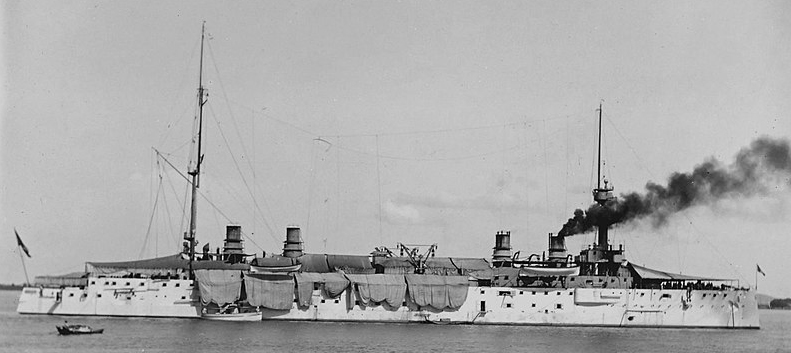
Sully (named after Henry IV marshall and statesman Maximilien de Béthune, Duke of Sully 1559-1641) was authorized in 1898, ordered from Forges et Chantiers de la Méditerranée on 24 May 1899, laid down the same in La Seyne-sur-Mer, and launched on 4 June 1901. She was completed in June 1904 and soon sent to French Indochina for her first commission. After a few weeks of servuce there, she struck an uncharted reef on 7 February 1905, in Hạ Long Bay. Fortunately where she was, the flooding was gradual and she settled, leaving time for her crew to evacuate in good order, without any casualty. Later small ships tried to salvage what could be, such as ammunitions and guns, or equipment in order to lighten her up. But while trying to refloat her due to tide movements she eventually broke in two. It was decided to abandon the wreck, stricken and considered a total constructive loss.
 FS Amiral Aube (1902)
FS Amiral Aube (1902)

FS Amiral Aube (named after Théophile Aube, 1826-1890, a colonial veteran of the war with China) was authorized in 1898, ordered from Chantiers de Penhoët on 9 August 1899. Laid down in February 1901 at Saint-Nazaire she was launched on 9 May 1902. Completed on 1 April 1904 at a cost of 24,336,000 francs, her crew came from the just paid off protected cruiser Guichen. Assigned to the 1st Cruiser Division, Northern Squadron, she carried out exercizes in the Atlantic and English channel in the same group as Condé and Gloire (flagship). They escorted the remains of John Paul Jones from France to Annapolis in April 1906. She visited New York City (enabling taking many photos, now in the libray of congress coll.). Later she was assigned to the 2nd Cruiser Division in January 1907. Amiral Aube was later versed to the 1st Cruiser Division (in October) and took part in the Quebec Tercentenary in Canada, berthed in quebeck city, just below the famous “Frontenac Hotel”, the occasion to take many more photos.
As the new République-class battleships entered service in late 1909, the French Navy reorganized these cruisers into the 2nd Squadron. From January 1911, she was in this unit with Gloire and Condé and from March she visited New York City. Deployed in the Mediterranean and training by mid-1911 she took part in the fleet review off in September. Reassigned to Reserve Group by November 1911 she was only fully reactivated by January 1914, assigned the 1st Cruiser Division, 2nd Light Squadron.
Now part of the 1st Light Division she was based in Cherbourg, trying to catch german vessels trying to pass the western Channel entrance blockade. Next, she also escorted troopships of the BEF to France, notably the 6th Infantry Division from Southampton. On 27 October, Amiral Aube and Gloire led a fleet of smaller cruisers patrolling until the eastern entrance was seal off by a barrage in 1915.
Reassigned in the Eastern Mediterranean from 24 December, 2nd Division, 3rd Squadron, Amiral Aube, Marseillaise and Gloire patrolled Egyptian waters, protecting Suez, as well as the Ottoman-held Levantine coasts. After all this time at sea without a proper refit, Marseillaise’s machinery needed more and more repairs until the general staff had enough and ordered her to Brest for a full drydock refit in March 1916. In May she was reassigned to the West Indies, looking for German commerce raiders with Gloire from Fort-de-France. The 3rd DL was disbanded and renamed “Atlantic and Antilles Division” from 1 June 1917 and she escorted convoys from Saint Thomas, from 15 February 1918 until the end of the war.
With the Bolsheviks signing the Treaty of Brest-Litovsk on 3 March 1918, she was sent to North Russia, supportig the Allied intervention from Murmansk on 18 March. She covered the occupation of Arkhangelsk on 10 August and was back home on 18 October, relieved by Gueydon. In early 1919, Amiral Aube was reassigned like her sisters to the Atlantic Division and eventually placed in reserve in March 1920, in Lorient. She was stricken on 7 July 1922 and sold for BU in 1924.
 FS Condé (1902)
FS Condé (1902)

FS Condé (after Louis Condé, famous Louis XIV’s generalissimo) was authorized in the 1896 Naval Program. Ordered from Arsenal de Cherbourg, on 17 September 1898 and then Arsenal de Lorient, 8 April 1898, she was eventually laid down on 29 January 1901 in the same slipway of FS Gloire. Launched the last in her class, on 12 March 1902, she was completed on 12 August 1904 at a cost of 21,594,975 francs.
Assigned to the 1st Cruiser Division, Northern Squadron with Gloire and Amiral Aube she had about the same career as the latter. She was in the Mediterranean Squadron by 1906. When the Light Squadron was split in half, Condé, Gloire and Amiral Aube went into the 2nd Light Division and from January 1911, 2nd Squadron. By August, she was in the 3rd Sqn, 3rd DL. Next the 2nd Light Squadron, 1st Cruiser Squadron, Atlantic Division in the French West Indies by early 1914. She took part in the US occupation of Veracruz by April 1914, protecting French citizens and interests off Mexico during the Revolution.
After the July Crisis, Condé and Descartes were at Veracruz in Mexico when recalled home. On 4 August they were assigned to the British 4th Cruiser Squadron trying to catch SMS Karlsruhe last spotted in the area. On 16 October, Condé teamed with HMS Berwick looking for other ships reported off the coast of Brazil. They were looking for the approaching German East Asia Squadron and prevent it to cross the Panama Canal as the US at the time were still neutral. The British Admiralty concentrated all its assets in the West Indies, including Condé on 8 November. However Von Spee was spotted off Chile five days later while Karlsruhe had been destroyed by an internal explosion on 8 November. Condé and Descartes remained in the West Indies until August 1915 and from 14 February HMAS Sydney reluieved Condé which could join her sisters in Martinique.
By January 1916 in the 3rd DL she took part in the search for German commerce raiders. Condé hiwever was pretty worn out after all this time and sent in France for a major overhaul at the Forges et Chantiers de la Gironde shipyard, Bordeaux, Western France, by July 1916. Since commerce raiders were now quite rare, by 1917, the local armored cruisers of the Atlantic and Antilles Division were tasked of escorts from late 1917, and started to cover the line St Thomas-St Nazaire from February 1918. Condé was ordered back alone however to the West Indies on 1 March. She later replaced the torpedoed armored cruiser Dupetit-Thouars in August 1918 and still in the Atlantic Division when the war ended.
Back to France by 28 May 1919, she carried 176 mutineers from French colonial infantry units to Casablanca, to be judged and interned. Condé relieved Gueydon in the Arctic on 25 June. There, she covered the French troops withdrawing from Arkhangelsk and later Murmansk on 12 October as the “reds” were advancing steadily. Reduced to “special reserve” on 15 March 1920 in Brest, Condé became a barracks ship in 1922 for the naval infantry in Lorient. In 1928, she became the HQ for the Naval Infantry School, but was stricken on 15 February 1933. From there, she was converted into a hulk instead of being scrapped. She was captured by the Germans in June 1940. They considerably modified her to be usable as a U-Boat depot ship. She was therefore spotted and sunk by Allied aviation in 1944. Her wreck was refloated in 1954 to be broken up.

























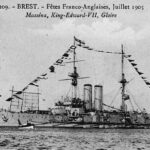



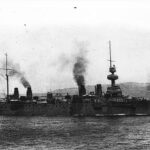
 Latest Facebook Entry -
Latest Facebook Entry -  X(Tweeter) Naval Encyclopedia's deck archive
X(Tweeter) Naval Encyclopedia's deck archive Instagram (@navalencyc)
Instagram (@navalencyc)





 French Navy
French Navy Royal Navy
Royal Navy Russian Navy
Russian Navy Armada Espanola
Armada Espanola Austrian Navy
Austrian Navy K.u.K. Kriegsmarine
K.u.K. Kriegsmarine Dansk Marine
Dansk Marine Nautiko Hellenon
Nautiko Hellenon Koninklije Marine 1870
Koninklije Marine 1870 Marinha do Brasil
Marinha do Brasil Osmanlı Donanması
Osmanlı Donanması Marina Do Peru
Marina Do Peru Marinha do Portugal
Marinha do Portugal Regia Marina 1870
Regia Marina 1870 Nihhon Kaigun 1870
Nihhon Kaigun 1870 Preußische Marine 1870
Preußische Marine 1870 Russkiy Flot 1870
Russkiy Flot 1870 Svenska marinen
Svenska marinen Søværnet
Søværnet Union Navy
Union Navy Confederate Navy
Confederate Navy Armada de Argentina
Armada de Argentina Imperial Chinese Navy
Imperial Chinese Navy Marinha do Portugal
Marinha do Portugal Mexico
Mexico Kaiserliche Marine
Kaiserliche Marine 1898 US Navy
1898 US Navy Sovietskiy Flot
Sovietskiy Flot Royal Canadian Navy
Royal Canadian Navy Royal Australian Navy
Royal Australian Navy RNZN Fleet
RNZN Fleet Chinese Navy 1937
Chinese Navy 1937 Kriegsmarine
Kriegsmarine Chilean Navy
Chilean Navy Danish Navy
Danish Navy Finnish Navy
Finnish Navy Hellenic Navy
Hellenic Navy Polish Navy
Polish Navy Romanian Navy
Romanian Navy Turkish Navy
Turkish Navy Royal Yugoslav Navy
Royal Yugoslav Navy Royal Thai Navy
Royal Thai Navy Minor Navies
Minor Navies Albania
Albania Austria
Austria Belgium
Belgium Columbia
Columbia Costa Rica
Costa Rica Cuba
Cuba Czechoslovakia
Czechoslovakia Dominican Republic
Dominican Republic Haiti
Haiti Hungary
Hungary Honduras
Honduras Estonia
Estonia Iceland
Iceland Eire
Eire Equador
Equador Iran
Iran Iraq
Iraq Latvia
Latvia Liberia
Liberia Lithuania
Lithuania Mandchukuo
Mandchukuo Morocco
Morocco Nicaragua
Nicaragua Persia
Persia San Salvador
San Salvador Sarawak
Sarawak Uruguay
Uruguay Venezuela
Venezuela Zanzibar
Zanzibar Warsaw Pact Navies
Warsaw Pact Navies Bulgaria
Bulgaria Hungary
Hungary

 Bundesmarine
Bundesmarine Dutch Navy
Dutch Navy Hellenic Navy
Hellenic Navy Marina Militare
Marina Militare Yugoslav Navy
Yugoslav Navy Chinese Navy
Chinese Navy Indian Navy
Indian Navy Indonesian Navy
Indonesian Navy JMSDF
JMSDF North Korean Navy
North Korean Navy Pakistani Navy
Pakistani Navy Philippines Navy
Philippines Navy ROKN
ROKN Rep. of Singapore Navy
Rep. of Singapore Navy Taiwanese Navy
Taiwanese Navy IDF Navy
IDF Navy Saudi Navy
Saudi Navy Royal New Zealand Navy
Royal New Zealand Navy Egyptian Navy
Egyptian Navy South African Navy
South African Navy






























 Ukrainian Navy
Ukrainian Navy dbodesign
dbodesign